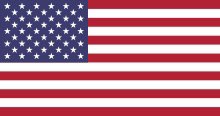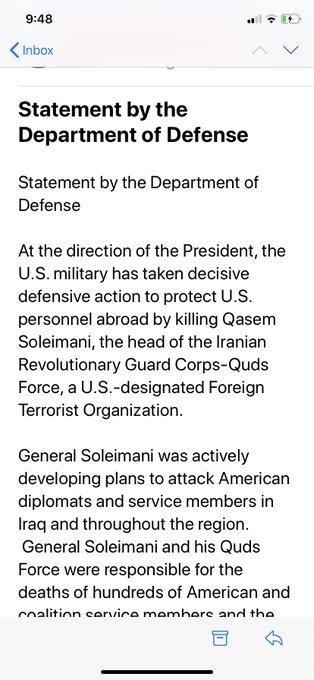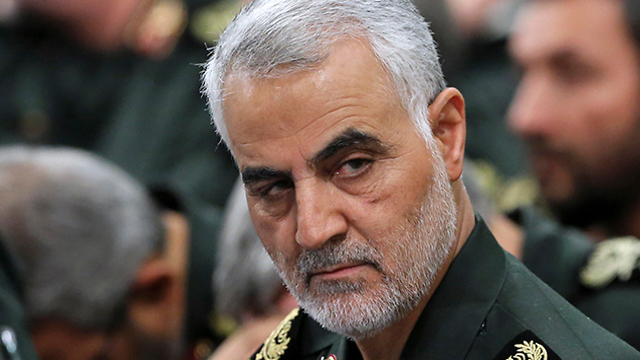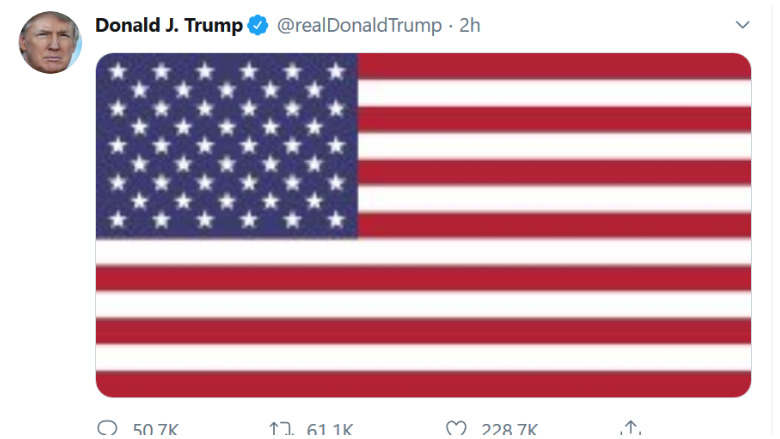
Twitter Trump's tweet on the death of Qasem Soleimani.
President Donald Trump has responded to news that a U.S. air strike he ordered killed Iranian general Qasem Soleimani with a tweet of an American flag.
This was President Trump’s response:
The tweet was liked more than 200,000 times in two hours and retweeted more than 61,000 times.
Meanwhile, Trump’s Secretary of State Mike Pompeo tweeted a video he says shows Iraqis dancing with joy in the streets at the news. “Iraqis — Iraqis — dancing in the street for freedom; thankful that General Soleimani is no more,” he wrote.
Congressional response was mixed with some Republicans applauding the president’s action, and some Democrats questioning what his plan is if escalation results.
Soleimani, an Iranian Major-General, head of the elite, powerful Quds force and architect of Iran’s strategy throughout the Middle East, was killed by an U.S. air strike, the U.S. Department of Defense has confirmed, calling the death “decisive defensive action.” The death of the powerful general marks what many experts are calling a potential turning point in the Middle East that is likely to generate retaliation from Iran against the United States.
Here’s what you need to know:
The Department of Defense Confirmed Soleimani’s Death
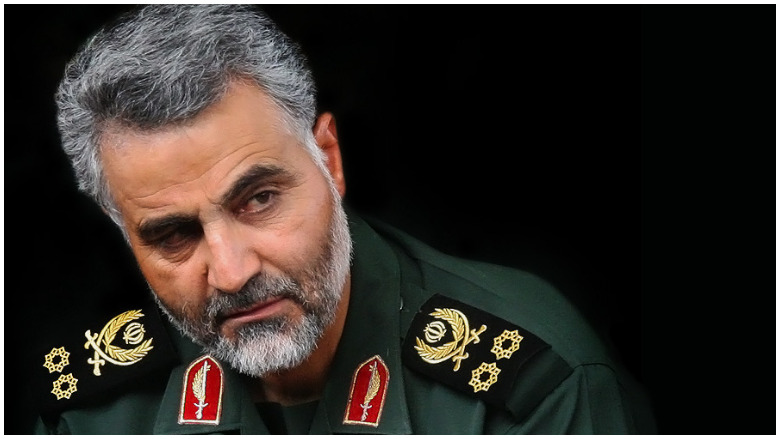
Wikimedia CommonsQassim Soleimani
“At the direction of the President, the U.S. military has taken decisive defensive action to protect U.S. personnel abroad by killing Qasem Soleimani, the head of the Iranian Revolutionary Guard Corps-Quds Force, a U.S.-designated Foreign Terrorist Organization,” the Department of Defense statement read. “General Soleimani was actively developing plans to attack American diplomats and service members in Iraq and throughout the region.”
The statement said that Soleimani and his Quds force “were responsible for the deaths of hundreds of American and coalition service members and the wounding of thousands more. He had orchestrated attacks on coalition bases in Iraq over the last several months — including the attack on December 27th — culminating in the death and wounding of additional American and Iraqi personnel.”
The statement concluded that the United States air strike “was aimed at deterring future Iranian attack plans. The United States will continue to take all necessary action to protect our people and our interests wherever they are around the world.”
How powerful was Soleimani? In a 2013 profile story, The New Yorker called Soleimani the “shadow commander” who was “reshaping the Middle East” and “directing Assad’s war in Syria.” At that time, the magazine described the Iranian general as “a small man of fifty-six, with silver hair, a close-cropped beard, and a look of intense self-containment.” The Washington Post dubbed Soleimani Iran’s “most revered military leader.”
According to Haaretz, Soleimani “was considered one of the people closest to Iran’s supreme leader, Ali Khamenei.” He was 61, a father of 5, a former construction worker, and not a religious scholar, Haaretz reports, adding that he ran the Quds force since 1998.
A 2018 article by Ali Soufan for the Combating Terrorism Center at West Point called him “one of Iran’s most popular living people.” His influence was felt throughout the Middle East, as he orchestrated Iran’s strategies in Syria, Iraq and other countries, Soufan wrote.
The New Yorker article says that Soleimani has the blood of American soldiers on his hands; he was known for “assassinating rivals, arming allies, and, for most of a decade, directing a network of militant groups that killed hundreds of Americans in Iraq.” The U.S. Department of the Treasury sanctioned Suleimani.
Tensions were already escalating with the Iran-backed militia attacks on the U.S. embassy in Iraq. Those attacks followed U.S. air raids “against Kataib Hezbollah militia bases” to avenge the death of a U.S. contractor in missile attacks in northern Iraq, according to Jerusalem Post. In contrast, the Obama administration had signed a nuclear deal with Iran.
In 2008, Suleimani texted then U.S. military commander David Petraeus that “he controlled Iran’s policy in Iraq and was outfoxing the Americans,” Daily Beast reports.
Soleimani’s Convoy Was Hit at Baghdad’s Airport & His Death Was Confirmed by Iranian State Television, Reports Say
According to Reuters, Ahmed al-Assadi, spokesman for Iran-backed militias, said: “The American and Israeli enemy is responsible for killing the mujahideen Abu Mahdi al-Muhandis and Qassem Soleimani.”
Iran has also confirmed the death via state TV. The general’s name is sometimes given as Qasem Soleimani and Qassem Soleimani.
The Iraqi militia spokesman told Reuters that Solemani was killed late on January 2, 2019 when the air strike hit his convoy in Baghdad airport. Killed along with him was Iraqi militia commander Abu Mahdi al-Muhandis, according to the news service.
Experts say the death could dramatically increase tensions with Iran, with President Donald Trump “upping the ante.” The Associated Press declared that the death of the general and others “are a potential turning point in the Middle East” likely to spark “severe retaliation” from Iran against Israel and America.
Earlier in the day, U.S. Defense Secretary Mark Esper released a detailed statement chronicling the American perspective on Iran. “Last Friday, the Iranian-backed militia Kata’ib Hizbollah or KH launched yet another attack against American forces in Iraq, resulting in the death of one American civilian, and injuries to four American service members, as well as two of our partners in the Iraqi Security Forces,” he wrote. “This continues a string of attacks against bases with U.S. forces and Iraqi Security Forces. KH has a strong linkage to the Iranian Revolutionary Guards Quds Force and has received lethal aid, support, and direction from Iran.”
Esper added: “U.S. leaders have repeatedly warned the Iranians and their Shia militia proxies against further provocative actions.”
He detailed how the Americans believe the militia attacks on the U.S. Embassy in Baghdad were backed by Iran, writing, “On Tuesday, December 31st, at the instigation of Shia militias, violent rallies of members of these militias outside the American embassy in Baghdad resulted in damage to exterior entry facilities and buildings at the embassy compound. We know it was Iranian-backed Shia militias because key leaders were spotted in the crowd and some militia members showed up wearing their uniforms and carried the flags of their militia, including KH.”
You can read that full statement here.
Graphic photos circulated on social media, with one showing a man’s hand with ring. Al-Jazeera reported that six other people were also killed in the attack.
